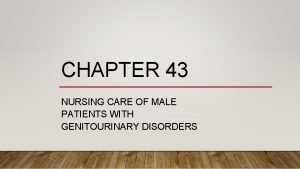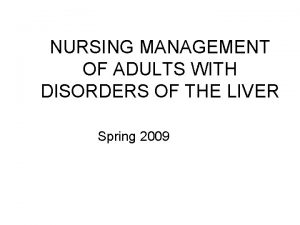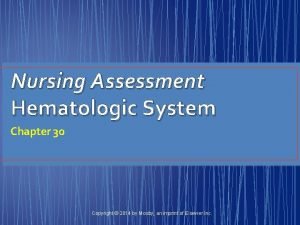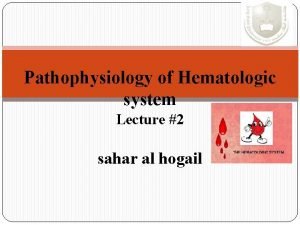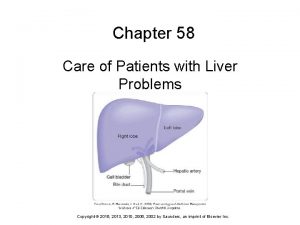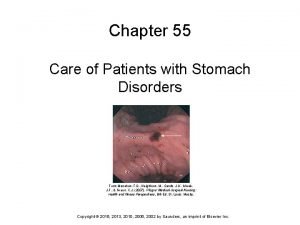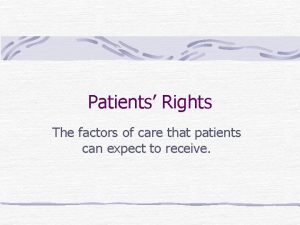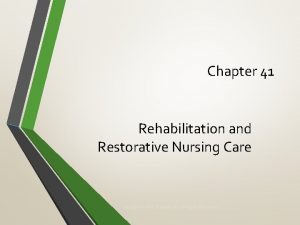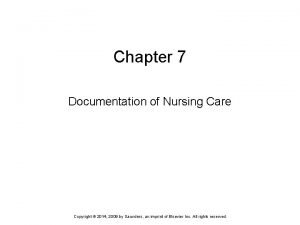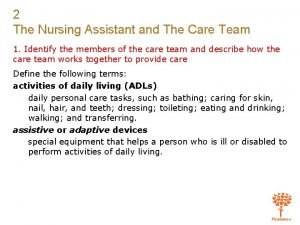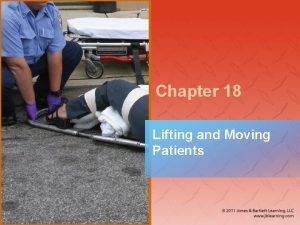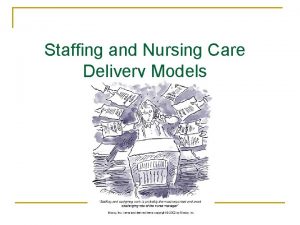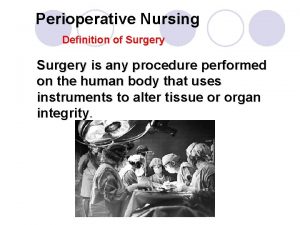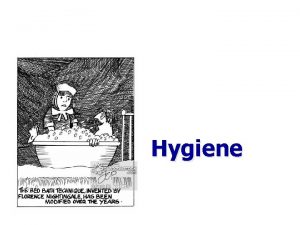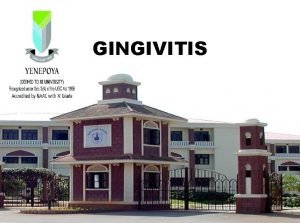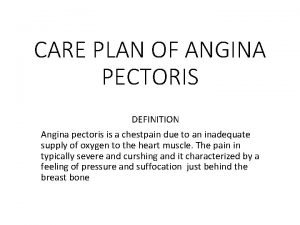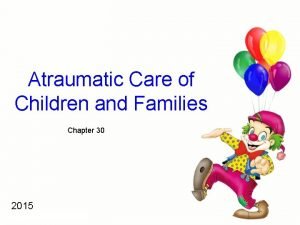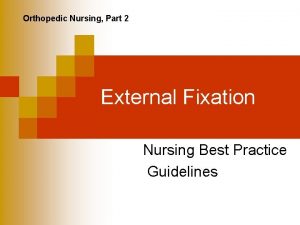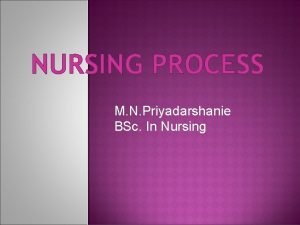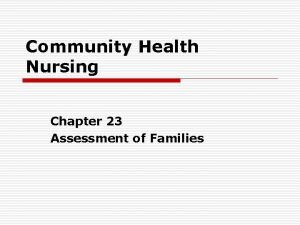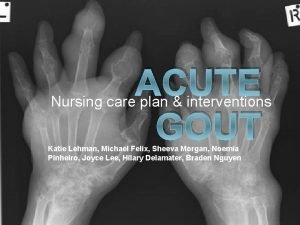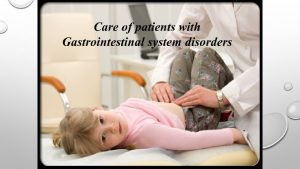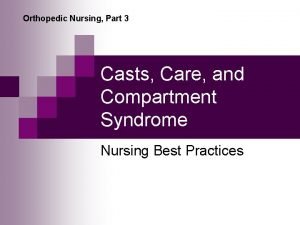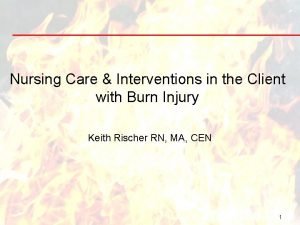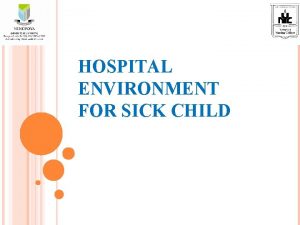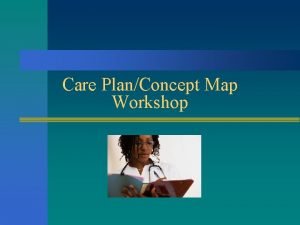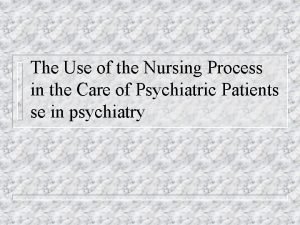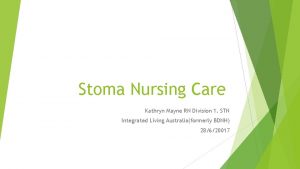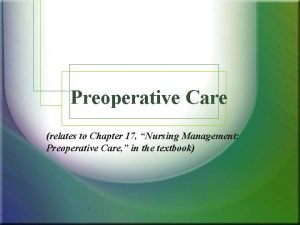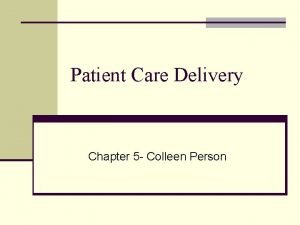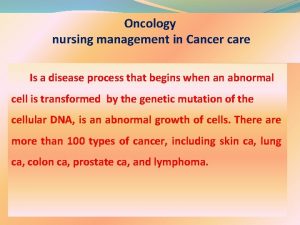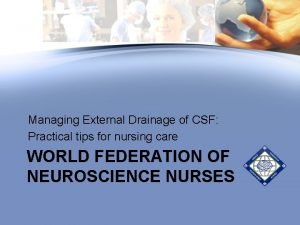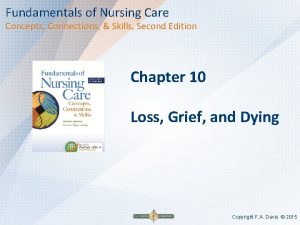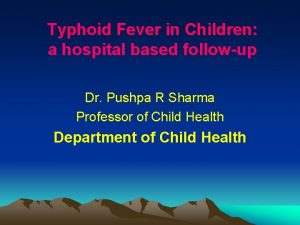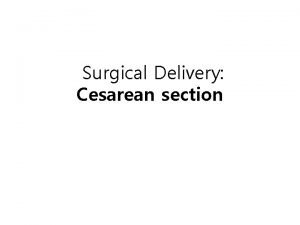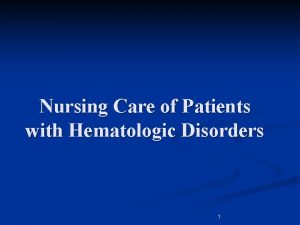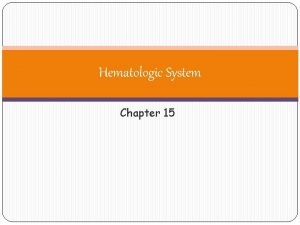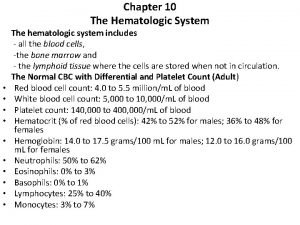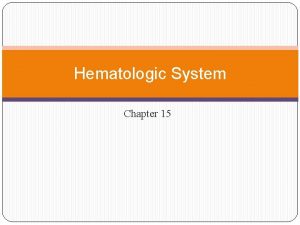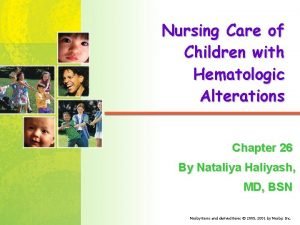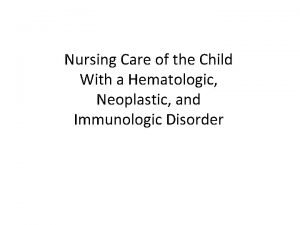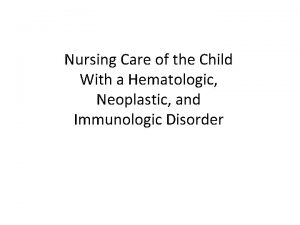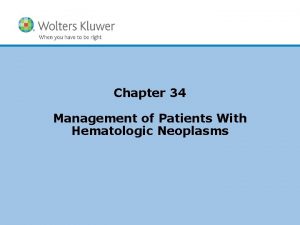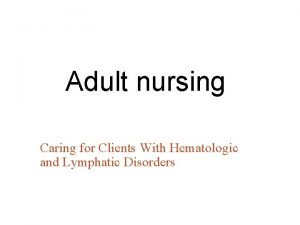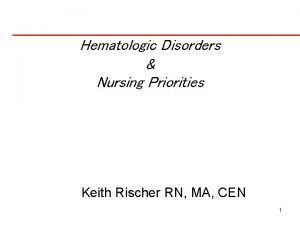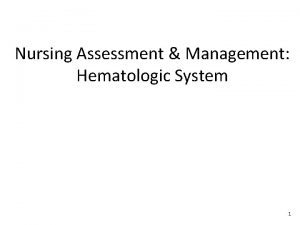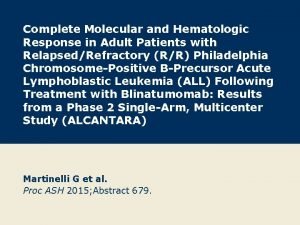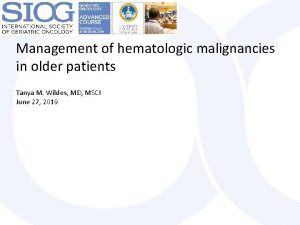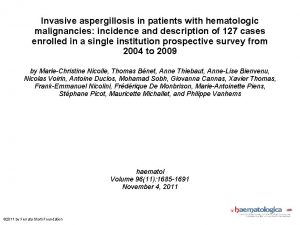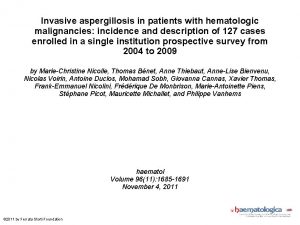Chapter 28 Nursing Care of Patients with Hematologic




































































- Slides: 68

Chapter 28 Nursing Care of Patients with Hematologic and Lymphatic Disorders

Anemia � Deficiency Both of Red Blood Cells, Hemoglobin, or ◦ Impaired Production ◦ Increased Destruction ◦ Blood Loss � Reduced Capacity to Carry Oxygen to Tissues

Etiologies � Dietary Deficiencies � Hemolysis � Hereditary Disorders

Signs and Symptoms � Pallor � Tachycardia � Tachypnea � Irritability � Fatigue � Dyspnea

Signs and Symptoms (cont’d) � Pernicious Anemia ◦ Numb Hands or Feet ◦ Sore Tongue � Iron Deficiency ◦ Mouth Fissures ◦ Glossitis ◦ Spoon-shaped Nails

Diagnosis � CBC with Microscopic Examination � Bone Marrow Analysis � Tests to Determine Source of Bleeding

Therapeutic Interventions � Eliminate Cause � Dietary Changes � Supplements � Transfusions

Nursing Diagnoses � Activity Intolerance � Imbalanced Nutrition � Risk for Injury � Impaired Oral Mucous Membranes

Aplastic Anemia � Bone Marrow Does not Produce Adequate RBCs � Causes ◦ Congenital ◦ Exposure to Toxins ◦ Chemotherapy

Signs and Symptoms Weakness Fatigue Pallor Dyspnea Headache Ecchymoses Petechiae Frank Bleeding Infection Death

Aplastic Anemia (cont’d) Diagnosis ◦ ◦ CBC Bone Marrow Biopsy TIBC Serum Iron Treatment ◦ Treat Cause ◦ Colony Stimulating Factors ◦ Steroids ◦ Bone Marrow Transplant

Sickle Cell Anemia Inherited Autosomal Recessive Disorder

Sickle Cell Anemia (cont’d) Diagnosis ◦ Sickledex Test ◦ Hemoglobin Electrophoresis ◦ CBC ◦ ESR Crisis Treatment ◦ ◦ ◦ Antibiotics Pain Management Transfusions Fluids Oxygen

Signs and Symptoms

Crisis Prevention � Avoid Risk of Reduced Oxygenation ◦ Exposure to Cold ◦ Infection ◦ Strenuous Exercise � Low Dose Penicillin � Frequent Transfusions � Hydroxyurea

Nursing Diagnoses � Risk for Ineffective Tissue Perfusion � Acute Pain

Patient Education � Avoid ◦ ◦ ◦ ◦ Tight Clothing Strenuous Exercise Alcoholic Beverages Cold Temperatures Smoking Unpressurized Aircraft Exposure to Infection

Polycythemia � Overabundance of Red Cells � Hemoglobin >18 mg/d. L � Hematocrit >55% � Blood Becomes Thick ◦ Primary ◦ Secondary

Signs and Symptoms Hypertension Visual Changes Headache Vertigo Dizziness Tinnitus Bleeding Chest Pain Dyspnea Dark, Flushed Skin Itching

Therapeutic Interventions � Phlebotomy � Low Dose Aspirin � Chemotherapy � Radiation Therapy

Patient Education � Drink 3 Liters of Water Daily � Avoid Restrictive Clothing � Elevate Feet � Report Signs and Symptoms of Iron Deficiency � Report Signs and Symptoms of Bleeding

Disseminated Intravascular Coagulation � Pathophysiology ◦ Accelerated Clotting ◦ Clotting Factors Depleted ◦ Bleeding � Etiology ◦ Major Trauma

Signs and Symptoms � Abnormal � Joint Bleeding Pain � Nausea and Vomiting � Organ System Failure � Convulsions � Shock, Coma � Death

Bleeding: Signs and Symptoms � Easy Bruising � Petechiae � Blood in Urine � Black Tarry Stools � Bleeding from Nose or Gums � New Onset of Painful Joints

Hemorrhage Into Skin

Diagnostic Tests � PT, PTT � Platelet Count � Hbg � Hemoglobin, Creatinine

Therapeutic Interventions � Correct Underlying Cause � Administer ◦ ◦ Blood FFP Platelets Cryoprecipitates

Nursing Care � Recognize and Report Bleeding � Avoid Trauma and Further Bleeding � Teach Patient and Family

Idiopathic Thrombocytopenic Purpura � Pathophysiology ◦ Platelet Destruction by Immune System ◦ Risk for Bleeding � Etiology ◦ Acute Viral Illness ◦ Drug Reaction ◦ Immune System Dysfunction

Signs and Symptoms Bleeding ◦ Petechiae ◦ Ecchymoses ◦ Bleeding

Diagnosis � Platelet Count � Bleeding Time � Bone Marrow Aspiration

Therapeutic Interventions � Steroids � Chemotherapy � Transfusions � Vitamin K � Chemotherapy � Splenectomy

Nursing Care � Bleeding Precautions � Recognize and Report Signs and Symptoms Bleeding � Teach Patient and Family

Bleeding Precautions � Use Electric Razor � Use Soft Toothbrush � Avoid Invasive Procedures, Injections � Maintain Pressure if Blood Draw Essential � Wear Shoes or Slippers

Bleeding Precautions (cont’d) � Avoid Bumps and Bruises � Avoid Aspirin and Nsaids � Administer Stool Softener � Handle Patient Gently � Gentle Nose Blowing

Hemophilia � Pathophysiology ◦ Missing Clotting Factors �A—Factor VIII �B—Factor IX � Etiology ◦ Heredity

Signs and Symptoms � Bleeding ◦ ◦ Joints Muscles Subcutaneous Tissue Brain

Diagnosis � PTT � Factor Levels

Therapeutic Interventions � Desmopressin � Clotting Factors ◦ Factor VIII ◦ Factor IX � Blood Transfusion

Nursing Diagnoses � Pain � Ineffective Protection � Risk for Ineffective Self Health Management

Leukemia � Pathophysiology ◦ Increase in Immature WBCs ◦ Unable to Fight Infection � Risk Factors ◦ Viruses ◦ Genetic Factors ◦ Radiation/Chemotherapy

Types of Leukemia � Acute Lymphocytic Leukemia � Acute Myelogenous Leukemia � Chronic Lymphocytic Leukemia � Chronic Myelogenous Leukemia

Signs and Symptoms Fever Infection Pallor Weakness Tachycardia Palpitations Dyspnea Abdominal Pain Malaise Sternal/Rib Pain CNS Changes Bleeding

Diagnosis � CBC � Bone Marrow Aspiration � Lumbar Puncture � Genetic Analysis

Therapeutic Interventions � Chemotherapy � Radiation Therapy � Bone Marrow Transplant � Peripheral Blood Stem Cell Transplant

Nursing Diagnoses � Risk for Injury: Infection, Bleeding � Fatigue � Impaired Oral Mucous Membranes � Knowledge Deficit � Anxiety

Multiple Myeloma � Pathophysiology ◦ Cancer of Plasma Cells in Bone Marrow ◦ Tumors Devour Bone Tissue ◦ Organ Invasion � Etiology ◦ Unknown ◦ Occupational Exposures

Signs and Symptoms � Bone � Fever Pain � Malaise � Spinal Cord Compression � Pathological Fractures � Hypercalcemia � Infection

Diagnosis CBC, Blood Calcium Bone X-Rays Urine for Bence Jones Protein Bone Marrow Biopsy

Therapeutic Interventions � Steroids � Chemotherapy � Control of Serum Calcium � Radiation � Stem Cell Transplantation � IV Pamidronate (Aredia)

Nursing Diagnoses � Risk for Infection � Risk for Injury ◦ Fracture ◦ Complications of Immobility ◦ Hypercalcemia

Hodgkin’s Disease � Cancer of Lymph System ◦ Presence of Reed-Sternberg Cells � Etiology ◦ Viral ◦ Genetic ◦ Immune Dysfunction

Signs and Symptoms � Painless � Pruritis � Pain Swollen Lymph Node Induced by Alcohol � Fever � Night Sweats � Weight Loss � Malaise

Late Signs and Symptoms � Edema of Face and Neck � Jaundice � Nerve Pain � Retroperitoneal Node Involvement � Spleen, Liver, and Bone Involvement

Diagnosis Biopsy ◦ Lymph Node ◦ Liver and Spleen ◦ Bone Marrow CT, Chest X-Ray Lung Bone Scan Lymphangiography CBC

Staging � Stage I: Single Lymph Node or Site � Stage II: Two or More Nodes on Same Side of Diaphragm � Stage III: Nodes on Both Sides of Diaphragm � Stage IV: Widely Disseminated Disease in Organs or Tissues

Therapeutic Interventions � Chemotherapy � Radiation Therapy

Nursing Diagnoses � Impaired Comfort � Activity Intolerance � Risk for Infection � Risk for Ineffective Coping

Non-Hodgkin’s Lymphomas � Lymphoma Arising from B Cells and T Cells � Absence of Reed-Sternberg Cells � Etiology ◦ ◦ Some Viruses H Pylori Immune Dysfunction Occupational Exposures

Signs and Symptoms � Painless Lymph Nodes � Enlarged Tonsils and Adenoids � Other Signs and Symptoms Similar to Hodgkin’s Disease

Diagnosis Biopsy ◦ ◦ ◦ Lymph Nodes Tonsils Bone Marrow Liver Other Bone Scan CT, Chest X-ray, IVP MRI, PET Scan Lymphangiography CBC Liver Function Studies Serum Calcium

Therapeutic Interventions � Chemotherapy � Monoclonal Antibodies � Interferon Therapy � Radiation Therapy � Stem Cell Transplant

Nursing Diagnoses � Activity Intolerance � Risk for Infection � Risk for Ineffective Coping

Comparison of Lymphomas Hodgkin’s ◦ ◦ ◦ Less Common Age 15 to 40 and >55 Reed-Sternberg Cells Younger Good Prognosis Alcohol-induced Pain Non-Hodgkin’s ◦ More Common ◦ Usually >Age 50 ◦ Absence of Reed. Sternberg Cells ◦ Poorer Prognosis

Splenectomy Surgical Removal of the Spleen

Preoperative Care � Baseline Labs � Blood Transfusion if Necessary � Vitamin K � Baseline Vital Signs � Teach Coughing and Deep Breathing

Postoperative Care � Monitor for Bleeding � Monitor Vital Signs � Administer Narcotics for Pain � Encourage to Cough and Deep Breathe and Ambulate

Complications of Splenectomy � Bleeding � Pneumonia � Atelectasis � Infection � OPSI
 Endocrine and hematologic emergencies
Endocrine and hematologic emergencies Preoperative nursing care for eye surgery
Preoperative nursing care for eye surgery Nursing diagnosis for undescended testis
Nursing diagnosis for undescended testis Esophageal varices nursing management
Esophageal varices nursing management Nursing assessment order
Nursing assessment order Hypochromic red cells
Hypochromic red cells Hematologic system assessment
Hematologic system assessment Chapter 58 care of patients with liver problems
Chapter 58 care of patients with liver problems Chapter 55 care of patients with stomach disorders
Chapter 55 care of patients with stomach disorders Obsessive compulsive disorder nursing care
Obsessive compulsive disorder nursing care What is position in nursing
What is position in nursing Ventriculostomy care
Ventriculostomy care Factors of care that patients can expect to receive
Factors of care that patients can expect to receive Levels of nursing care primary secondary tertiary
Levels of nursing care primary secondary tertiary Chapter 41 rehabilitation and restorative nursing care
Chapter 41 rehabilitation and restorative nursing care Pie nursing charting
Pie nursing charting The nursing assistant and the care team chapter 2
The nursing assistant and the care team chapter 2 Chapter 2 foundations of resident care
Chapter 2 foundations of resident care Dope mnemonic emt
Dope mnemonic emt Direct ground lift emt
Direct ground lift emt Chapter 8 lifting and moving patients
Chapter 8 lifting and moving patients Short backboard device
Short backboard device Patient care delivery models
Patient care delivery models Psychiatric nursing process
Psychiatric nursing process Nursing process in psychiatric nursing
Nursing process in psychiatric nursing Define nursing process
Define nursing process Team nursing care delivery model
Team nursing care delivery model Associative looseness
Associative looseness Post operative nursing management
Post operative nursing management Preoperative checklist definition
Preoperative checklist definition Nursing care of hospitalized child
Nursing care of hospitalized child Post operative nursing care
Post operative nursing care Nail care procedure in nursing
Nail care procedure in nursing Nursing care plan for gingivitis
Nursing care plan for gingivitis Cleft lip and palate post operative care nursing diagnosis
Cleft lip and palate post operative care nursing diagnosis Nursing care plan of angina pectoris
Nursing care plan of angina pectoris Post operative nursing care
Post operative nursing care Atraumatic care pediatric nursing
Atraumatic care pediatric nursing Atraumatic care in pediatric nursing
Atraumatic care in pediatric nursing Henderson 14 basic needs
Henderson 14 basic needs Somatization disorder
Somatization disorder External fixation device nursing care
External fixation device nursing care Nursing care plan case scenario
Nursing care plan case scenario Nursing care of hospitalized child
Nursing care of hospitalized child Contraindications nails
Contraindications nails Family care plan in community health nursing
Family care plan in community health nursing Nursing diagnosis for gout
Nursing diagnosis for gout Nursing care logo
Nursing care logo Colostomy nursing responsibilities
Colostomy nursing responsibilities Minerva cast ortho
Minerva cast ortho Nursing care plan for burns
Nursing care plan for burns Physical environment for sick child in pediatric ward
Physical environment for sick child in pediatric ward Nursing care plan concept map
Nursing care plan concept map Nursing care plan for homicidal ideation
Nursing care plan for homicidal ideation Nursing diagnosis for impaired swallowing
Nursing diagnosis for impaired swallowing Stomas
Stomas Nursing management preoperative care
Nursing management preoperative care Primary nursing vs total patient care
Primary nursing vs total patient care Mylosuppresion
Mylosuppresion Wholly compensatory system examples
Wholly compensatory system examples Stages of cirrhosis
Stages of cirrhosis Nursing diagnosis of phobia
Nursing diagnosis of phobia Nursing diagnosis for pulmonary embolism
Nursing diagnosis for pulmonary embolism Patho
Patho Lumbar drain picture
Lumbar drain picture Fundamentals of nursing care concepts connections & skills
Fundamentals of nursing care concepts connections & skills Buck traction nursing care
Buck traction nursing care Nursing care plan for typhoid fever slideshare
Nursing care plan for typhoid fever slideshare Steps of lscs
Steps of lscs


